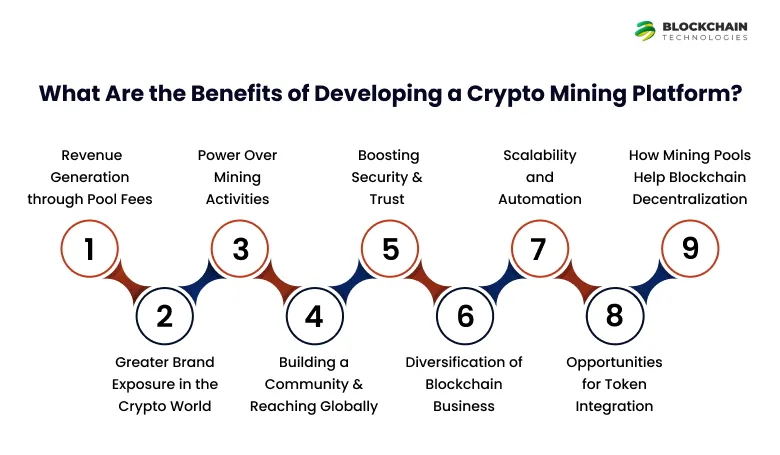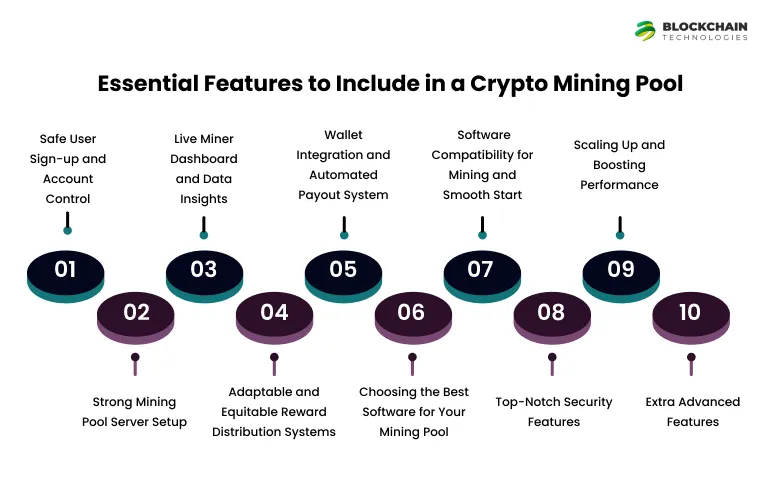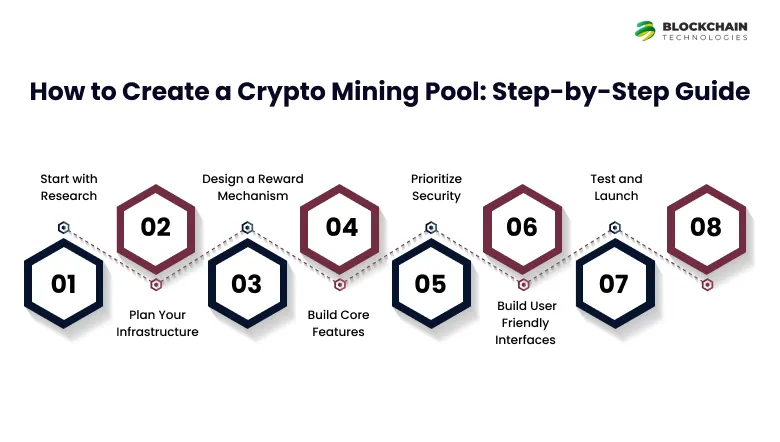How to Create a Cryptocurrency Mining Pool: A Detailed Guide with Real-life Use Cases
May 20,2025
How to Create a Cryptocurrency Mining Pool: A Detailed Guide with Real-life Use Cases
Starting a crypto mining pool can boost your brand’s visibility in the blockchain world and the broader blockchain mining community. It connect you to miners and crypto fans worldwide. The crypto mining industry continues its steady growth in 2026, powered by rising demand for PoW networks like Bitcoin, Kaspa, Litecoin, and Dogecoin. With global mining revenue projected to reach $5.29 billion by 2028 (Fortune Business Insights), launching your own mining pool is a lucrative opportunity with long-term potential.
At Blockchaintechnologies, we focus on cryptocurrency development services. We help forward-thinking companies set up, launch, and fine-tune crypto mining pools that perform at a high level with great accuracy. If you’re wondering how to set up a cryptocurrency mining pool from scratch, this guide will help you to avoid common mistakes and cover everything from setup to scaling
What Are the Benefits of Developing a Crypto Mining Platform?

Starting your own crypto mining platform—also called a mining pool—can be a game-changer for businesses and entrepreneurs in the Web3 and blockchain world. Here’s a look at the main advantages:
1. Revenue Generation through Pool Fees
A mining platform makes money by taking a small cut (1% to 3%) of miners’ earnings as a fee. Your ongoing income grows as more miners join your pool.
Example: A mining pool with 1,000 active users paying $0.50/day in fees can bring in over $15,000/month.
2. Greater Brand Exposure in the Crypto World
Running a mining pool puts your brand in the spotlight of the blockchain community. It creates trust and recognition among crypto miners, traders, and developers, making you a key player in the Web3 arena.
Real-Life Example: Companies like F2Pool and ViaBTC began as small pools but grew into big names in blockchain infrastructure.
3. Power Over Mining Activities
By managing your own platform, you get complete power over:
- The mining software in use
- Ways to share rewards (PPS, FPPS, PPLNS)
- Pool management
- Network rules and user guidelines
This gives you more control to customize and optimize compared to joining pools run by others.
4. Building a Community & Reaching Globally
A mining pool links you to miners, developers, and crypto fans worldwide. This provides you with useful feedback from users and growth driven by the community. You can:
- Start referral programs
- Add chat or support features
- Provide mining guides and token rewards
5. Boosting Security & Trust
With your platform, you can set up top-notch security measures, like DDoS protection encrypted wallets, and constant monitoring, to gain your users’ trust and protect valuable assets.
6. Diversification of Blockchain Business
If you’re already in crypto, maybe as a DeFi or NFT project, adding a mining pool helps to broaden your services and build a self-sustaining ecosystem. It boosts your overall Web3 strategy.
7. Scalability and Automation
New mining pool platforms can run on autopilot to handle:
- Miner onboarding
- Performance tracking
- Reward payouts
- Wallet integrations
This cuts down on operational costs and allows for easy growth as your user base expands.
8. Opportunities for Token Integration
You have the option to incorporate your own native token into the reward system for mining or use mining participation as a way to access token staking, rights to governance, or upcoming airdrops. This enhances user involvement and gives your crypto token more value.
9. How Mining Pools Help Blockchain Decentralization
When you run a mining pool—for smaller or newer cryptocurrencies—you boost network decentralization, which plays a key role in blockchain security and consensus without trust.
How to optimize mining pool profitability?
Risks & Regulatory Considerations Even though mining pools offer reliable revenue, they also come with risks and tight compliance requirements:
- Energy Regulations: Countries are introducing caps or higher tariffs on large-scale mining operations.
- Environmental Compliance: Some regions demand renewable energy usage or carbon reporting.
- Jurisdictional Risks: Laws differ across US, EU, UAE, India, and East Asia. Some regions may restrict mining.
- Security Risks: DDoS attacks, 51% vulnerabilities, and poor miner distribution can affect pool stability.
- Legal Structure: Many mining pools now require registration and clarity on fee disclosures, reward distribution, and operator responsibilities.
Blockchain Technologies assists with compliance-friendly architecture so your mining pool can operate safely across multiple regions.
Launch Your Own Mining Pool Today
Get expert guidance from blockchain professionals.
Cost & ROI Snapshot for Mining Pools
While costs vary by scale, most mining pool operators need to budget for:
- Server hosting & redundancy
- Security infrastructure (DDoS prevention, load balancing)
- Development & maintenance of pool software
- Payment processing systems
- Energy and cooling (if operating a hybrid self-mining model)
- Legal & compliance overhead
ROI Factors Include:
- Total connected hash rate
- Miner loyalty/retention
- Fee percentage (commonly 0.5% – 3%)
- Network difficulty trends
- Block reward economics
- Power-cost strategy
With optimized infrastructure, most mining pools achieve ROI within 6–18 months, depending on market conditions.
Essential Features to Include in a Crypto Mining Pool

1. Safe User Sign-up and Account Control
A good, safe user experience begins here. Your mining pool should have:
- A system for users to sign up and log in with email checks.
- Two-step verification (2FA) to boost security.
- Account management allows users to change wallet addresses personal details, and payment settings.
- Dashboard shows individual mining data, profits, and past actions.
- Permission-based system controls admins, help staff, or lower-level users.
Why it’s key: Mining involves money transfers. Any security breach can result in lost funds or exposed information.
2. Strong Mining Pool Server Setup
Your backend server forms the heart of your mining pool. It needs to handle thousands of miners at once. Key parts include:
- Quick high-power servers that cut down on rejected shares and speed up responses.
- Servers around the world to serve international miners with little downtime.
- Spreading the workload across several servers boosts performance and keeps the system running.
- Backup and redundant systems prevent the pool from shutting down if one part fails.
Quick Tip: Use cloud-based or containerized setup (like Docker + Kubernetes) to scale .
3. Live Miner Dashboard and Data Insights
Miners need to see how they’re doing. Your dashboard should show:
- Current hash rate tracking (for each miner and the whole pool).
- Device monitoring to check how each connected mining machine performs.
- Accepted vs. rejected shares outdated share tracking, and online time logs.
- Predicted daily/weekly/monthly earnings based on how well things are going.
- Graphs and pictures to help spot trends and unusual patterns more easily.
Benefit: This creates openness and builds trust with your users.
4. Adaptable and Equitable Reward Distribution Systems
How well (and ) you pay miners plays a crucial role in keeping them. Your pool should provide:
- Various payout models:
- PPS (Pay Per Share): Miners receive payment for every share they submit.
- FPPS (Full Pay Per Share): Includes fees from transactions in the payout.
- PPLNS (Pay Per Last N Shares): Rewards based on actual contribution to blocks.
- Custom payout limits so users can choose when they want to get paid.
- Options for automatic payouts and manual withdrawals.
- Comprehensive payout history records with IDs for transactions and links to blockchain explorers.
Why it matters: Models with flexibility help you attract different types of miners—from hobbyists to big operations.
5. Wallet Integration and Automated Payout System
Crypto payout systems that work well are key. Include:
- Support for multiple currency wallets for Bitcoin, Ethereum, Litecoin, and others.
- Built-in hot wallets to enable quick and automatic payouts.
- Cold wallet choices to keep reserves safe.
- A payout scheduler to automate payments at set times (e.g., at midnight).
- Logic to optimize gas/fees to cut down on extra transaction costs.
Tip: Add APIs from big wallet providers like MetaMask, Coinbase Wallet, or custom on-chain wallets.
6. Choosing the Best Software for Your Mining Pool
The best software you use plays a crucial role in compatibility and performance. Evaluate options like CGMiner, BFGMiner, and EasyMiner based on your mining algorithm and hardware. Ensure that the software supports real-time data sharing, custom configs, and can be monitored easily by your dashboard.
7. Software Compatibility for Mining and Smooth Start
- Miners rely on external programs to link up with pools. Make sure:
- Your pool works with popular mining software like CGMiner, BFGMiner, EasyMiner, PhoenixMiner, or Gminer.
- Miners can connect using stratum+tcp or stratum+ssl through basic stratum protocol integration.
- You provide clear instructions for setting up mining software and linking workers.
- Your dashboard offers a tool to generate sample settings (like a “copy & paste” feature for miner configs).
Dev Tip: Giving setup help and quick support can keep more miners on board and reduce headaches.
Need Help Choosing the Right Mining Software?
Our experts can guide you in selecting and configuring the ideal mining software for your pool.
8. Top-Notch Security Features
Crypto platforms often attract cyberattacks. Put these measures in place:
- SSL/TLS encryption to protect user data and secure communication between pools and servers.
- DDoS protection (using services like Cloudflare or custom firewalls).
- Safeguards against brute force attacks, IP whitelisting, and filters for bot traffic.
- Encryption of sensitive user data such as wallet addresses, in databases.
- Logging of admin control panel access for audit purposes.
Keep in mind: A single major breach can destroy the reputation of your entire mining pool brand.
9. Scaling Up and Boosting Performance
- Your platform needs to grow with your user base. Make sure to include:
- A modular structure that allows you to add or update features without interrupting service.
- Spreading out across nodes to increase your capacity to handle more hashes.
- Caching and queue systems (such as Redis RabbitMQ) to handle large volumes of user requests.
- Tools like Prometheus + Grafana to monitor performance in real-time and send alerts.
Why this counts: Mining operates 24/7—availability and quick response times affect earnings and user confidence.
10. Extra Advanced Features
To gain an edge over rivals, think about adding:
- A mobile app for miners to check their stats while on the move.
- A system for referral programs with links that can be tracked and bonus rewards.
- Alerts via the app or text messages for payouts, worker downtime, or issues.
- Features that build community, like spaces for chat or discussion boards.
Connection with DeFi or staking options offering functionality across platforms.
How to Create a Crypto Mining Pool: Step-by-Step Guide

Creating a crypto mining pool isn’t just about having the right tech skills; it’s all about strategic planning, building a solid infrastructure, ensuring security, and crafting a great user experience. Here’s a step-by-step guide to help you navigate the process:
1. Start with Research
Before diving into coding or purchasing servers, take the time to do some thorough research:
- Which coin to mine: Look into coins that still operate on Proof-of-Work (PoW) like Bitcoin, Litecoin, or Monero.
- Market demand: Is there a vibrant community of miners? Are they on the lookout for new or smaller pools?
- Competition analysis: Check out existing pools. What services do they provide? What are their fee structures, rewards, and uptime like?
- Mining algorithms: Get to know the algorithm used by your chosen coin (like SHA-256, Scrypt, or RandomX) and what technical requirements come with it.
Goal: Pinpoint a clear market opportunity and confirm that a new pool will draw in miners.
2. Plan Your Infrastructure
After selecting your coin and concept, it’s time to plan your mining setup, which includes designing the technical framework, hardware selection, and server configuration:
- Select your servers: Opt for cloud-based VPS or dedicated servers that boast high uptime, SSD storage, and robust bandwidth.
- Setup location: If you’re aiming for international miners, consider deploying globally distributed nodes to reduce latency.
- Install OS and tools: Go for Linux (Ubuntu is a solid choice) and include dependencies like Node.js, Redis, MySQL, and any necessary libraries.
Pro tip: Your infrastructure should be built to handle high throughput and be fault-tolerant to maintain stability even under heavy loads.
3. Design a Reward Mechanism
At the heart of what keeps miners motivated is a solid reward mechanism. Here are some popular options:
- PPS (Pay Per Share): This model pays miners a set amount for every valid share they submit.
- PPLNS (Pay Per Last N Shares): A bit riskier, but it’s favored for its fairness and helps reduce pool-hopping.
- FPPS: This one includes transaction fees in the rewards.
When you’re putting together your payout structure, keep these points in mind:
- Set your pool fees (typically around 1-2%).
- Decide how often you want to pay out (hourly, daily, or based on a threshold).
- Think about offering both automatic and manual payouts.
- It’s crucial to ensure that your system accurately calculates shares and can securely handle high-volume payouts.
Planning to Launch a Mining Pool?
We’ll estimate your project for free—no strings attached.
4. Build Core Features
Now it’s time to get into the nitty-gritty of your mining pool’s functionality. Key components include:
- Stratum server: This is what allows communication between the pool and the miners.
- Blockchain node integration: You’ll need to connect with the full node of your chosen cryptocurrency to detect blocks and verify shares.
- Job dispatcher: This sends tasks to miners and manages the difficulty levels.
- Share tracker: This keeps track of and logs the contributions from miners.
- Payment processor: This calculates rewards and initiates payouts.
Using open-source frameworks like Yiimp or NOMP can help speed up your development process, but make sure to tailor them to fit your specific business needs. Custom features such as failover nodes, miner grouping, or smart load balancing can really set your pool apart from the competition.
5. Prioritize Security
Mining pools are prime targets for hackers, so having strong security measures is absolutely essential:
- DDoS protection: Utilize services like Cloudflare or set up custom firewalls to fend off attacks.
- TLS/SSL encryption: Make sure all traffic between miners and servers is encrypted.
- Wallet protection: Safeguard your hot wallets and think about using cold wallets for storing reserves.
- Authentication & access controls: Implement two-factor authentication for users and role-based access for administrators.
- Regular audits: Keep scanning for vulnerabilities and ensure your software is up to date.
The trustworthiness of your pool largely hinges on how effectively it safeguards miner funds and data.
6. Build User-Friendly Interfaces
Your frontend (website and dashboard) serves as the control center for users. Key features should include:
- Real-time dashboard: Display miner hashrate, submitted shares, earnings, and worker status.
- Registration & login system: Ensure secure account management with two-factor authentication and password recovery options.
- Support ticket or chat system: Provide a way for miners to ask questions and get technical assistance.
- Admin panel: Oversee performance, manage payouts, ban malicious users, and adjust settings.
Consider using frameworks like React or Vue.js to design a modern UI that works well on both mobile and desktop. A clear and intuitive interface fosters trust and boosts miner loyalty.
7. Test and Launch
Before you go live:
- Test with private miners: Create a testnet environment or enlist a small group of beta testers.
- Simulate load: Replicate real-world mining conditions to evaluate performance and scalability.
- Verify payouts: Carefully check all wallet transactions and reward distributions.
- Fix bugs & optimize: Address any UI/UX or backend issues that arise.
Once everything is stable, launch your mining pool to the public with marketing efforts:
- List on directories (like miningpoolstats.stream)
- Engage with mining communities (Reddit, Telegram, Discord)
- Provide launch incentives such as 0% fees or bonus payouts
The launch phase is crucial—make sure your system is secure, responsive, and delivers real value right from the start.
8. Managing and Maintaining Your Crypto Mining Pool
Once your mining pool is live, ongoing management is key. Regular tasks include:
- Monitoring server uptime and latency
- Applying software updates and patches
Responding to user tickets and technical queries
Conclusion
Creating a successful crypto mining pool is quite the adventure—one that calls for thoughtful planning, technical know-how, and a focus on the user experience. By following the comprehensive steps and insights we’ve shared in this guide, you can establish a mining pool that offers value, performance, and trust to a worldwide community of miners.
At Blockchaintechnologies, we’re all about providing complete cryptocurrency development services. We help clients transform their innovative mining pool concepts into scalable, secure, and profitable platforms.
Are you ready to embark on the journey of building your own crypto mining pool? Let’s connect and turn your vision into reality with dependable technology, customized strategies, and expert guidance.
Join the Future of Crypto Mining
Launch a high-performance mining pool with us.
FAQs
A crypto mining platform is a virtual infrastructure that enables miners to pool their computing resources to mine cryptocurrencies effectively. The platforms perform block validation, reward distribution, and transaction verification using specialized software, algorithms, and server clusters.
The price of building a cryptocurrency mining platform depends on features, complexity of architecture, tech stack, and security needs. On average, simple mining pool development can begin at $10,000–$50,000, and custom, enterprise-level platforms can be over $100,000. Asking for a free estimation assists in determining your budget correctly.
The timeframe for building a crypto mining platform varies based on your needs. An MVP (Minimum Viable Product) can take 3 to 6 months, while a full-featured solution will take 6 to 9 months, including development, QA, and deployment.
The main features are:
- User dashboard with mining statistics
- Reward distribution system (PPS, PPLNS, etc.)
- Integration with wallets
- Hash rate tracking in real-time
- Security measures (DDoS protection, 2FA)
- Admin panel
- Miner onboarding & KYC (optional)
Yes. Mining pool operators can make money by charging pool fees, providing premium services, or operating cloud mining schemes. Providing uptime, performance, and reliability attracts and retains active miners.
While Bitcoin, Ethereum (before the Merge), and Litecoin were mined in the traditional manner, you can now build mining pools for other altcoins such as Dogecoin, Monero, Ravencoin, or Kadena. The backend of the platform has to be adapted to the target coin’s consensus algorithm and protocol.
Yes. Hiring an experienced Web3 and blockchain development company ensures your platform is secure, scalable, and compliant with crypto regulations. Specialists understand consensus algorithms, reward systems, and wallet integrations, reducing risk and technical debt.
Typical tech stacks include:
- Backend: Node.js, Python, Go
- Frontend: React, Vue.js
- Database: PostgreSQL, MongoDB
- Blockchain APIs & SDKs
- Security: SSL, Anti-DDoS, OAuth, 2FA
- DevOps: AWS, Docker, Kubernetes
Yes. Platforms can support wallet integrations like MetaMask, Trust Wallet, or hardware wallets, and connect with crypto payment gateways for reward payouts or fiat conversions.
Absolutely. With cloud infrastructure (AWS, Azure) and microservices architecture, your platform can scale elastically. Caching, load balancing, and database optimization are the crucial components to facilitate high concurrency.
